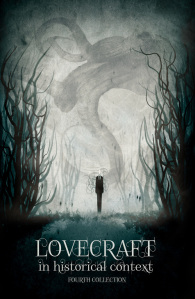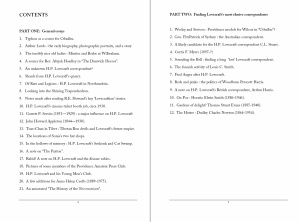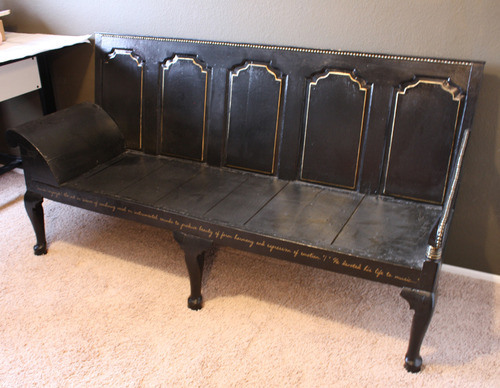Assignment Nine, Vacation Necronomicon School: “From Beyond”.
Your brief writing assignment is to relate some aspect of today’s reading to another Lovecraft story “From Beyond”
Looking into Lovecraft’s toilet
The early story “From Beyond” (1920) is generally regarded as one of Lovecraft’s most flushable stories, and indeed it was not published until it saw light in The Fantasy Fan (June 1934, Vol. 1, No. 10). This essay suggests linkages between some of the story’s motifs, the house Lovecraft then occupied, and the villain Tillinghast.
First, who might Tillinghast be likely to have been based on? There was a “Tillinghast Supply Machine Company, Boston” in 1919. (Abstract of the Certificates of Corporations, Massachusetts Office of the Secretary of State, 1920). Although incorporated in Boston, the company was prominently based in Providence, and supplied plumbing materials and fittings at both retail and wholesale…
L.H. Tillinghast Supply Co., 162 to 168 Dorrance Street, Providence.
‘A Complete Stock of Everything pertaining to Plumbing. For thirty-seven years we have been manufacturers of and dealers in high grade plumbers’ supplies.’ — Year-book of the Rhode Island Chapter, American Institute of Architects, 1911.
Dorrance Street was the main road that led to the Providence railway station, and Lovecraft must have known it well. L.H. Tillinghast advertised in The Providence Directory of 1920, and Lovecraft may have seen their adverts for new toilets and sinks in the newspapers. Their president, at the time Lovecraft wrote his story, was the deliciously-named Lodorick Hoxie Tillinghast, a prominent Providence businessman and local worthy.

One wonders if Tillinghast was then a leading company installing domestic flushing toilet (then also called a “water closet” or “lavatory”) in Providence, as the city suburbs and towns of New England switched from chamber pots and outside privies to inside toilets? Certainly, Dorrance Street was obviously a major commercial street and not some poky little back street, and the long-established nature of the firm seems to suggest it had a wide range and reach. Tillinghast is of course a common local name, but one even wonders if the Tillinghast name may have been imprinted on Lovecraft’s toilet bowl at 598 Angell Street, or on some associated element?
At that time, toilets were perhaps not quite as advanced as the modern ones, and were a lot noisier and possibly more smelly…
‘an antique water closet, essentially an indoor outhouse. They were decorative, like furniture, until the owner lifted the lid or inhaled the bouquet.’ — Citro, Curious New England, 2004.
I think there is some very interesting evidence in the text of the story “From Beyond” to suggest a strong linkage between it and the everyday experience of visiting the toilet. I think I can show that “From Beyond” could be a potent fusion of high philosophy and the low odours arising from the experience of the indoor toilet — and thus from the cultural and personal cloud of anxieties that then surrounded that dreadfully liminal domestic space.
First let me remind readers of Lovecraft’s domestic circumstances in 1920. Since 1904 Lovecraft had shared a rented residence at 598 Angell Street, Providence. Donald Tyson describes this as…
‘a five-room apartment that made up the first floor of a somewhat smaller house [than the family had been used to previously]’ — The Dream World of H. P. Lovecraft, 2010.
This sounds rather cramped, although S.T. Joshi suggests that the boy Lovecraft also had access to (officially or unofficially) the attic — which incidentally is where the action in “From Beyond” takes place…
I looked about the immense attic room with the sloping south wall, dimly lit by rays which the every-day eye cannot see. The far corners were all shadows, and the whole place took on a hazy unreality which obscured its nature and invited the imagination to symbolism and phantasm.
This vision-space is later referred to as an “incredible temple” and “temple-like”, which brings to mind the colloquial description of the domestic toilet as a ‘throne’.
Given the shared nature of the house was it possible that Lovecraft was sharing a toilet with more people than just his female relatives? Sadly, no-one appears to have yet looked into the matter of Lovecraft’s toilet.
There had certainly been anxieties expressed on the subject of shared toilets in New England…
‘Modesty is hardly possible when from four to ten people of varying ages and both sexes live in from two to four rooms, some of them very small. Insufficient water-closet facilities also conduce to a low standard of morals.’ — The New England magazine, Volume 19, 1899.
Also, Chris Perridas has usefully uncovered a letter indicating the dreadful nature of the boys’ toilets in 1912, at the school Lovecraft attended…
‘At the Hope Street School the urinals are offensive, both in odor and appearance, and a positive menace to health. The toilet room is situated opposite the lunch room, and the caterer has spoken frequently of the noisome odors that permeate the basement. Teachers notice the odors as they pass the staircase on the floor above. Even pupils complain.’ — letter of 1912 from Charles E. Dennis, quoted by Chris Perridas in Dec 2010.
All this has obvious relevance to ‘body horror’, the nature of what is ‘beyond’ the u-bend, the emergence of slime into water, etc. But what might the evidence be in the story itself? In “From Beyond” the hero is taken to the attic laboratory (a word so curiously similar to lavatory, and in which he sees a toilet-bowl -like vision of… “a void, and nothing more”), where he enacts some of the key aspects of visiting the toilet to excrete. For instance, the machine which the hero sits near is “detestable” and connected with “chemicals”, rather like a toilet…
‘detestable electrical machine, glowing with a sickly, sinister, violet luminosity. It was connected with a powerful chemical battery’
The key evidence from the story is the descriptions of his sensations while engaged with the machine. These can easily be read as those of sitting on the toilet, passing wind, the holding of one’s breath, and then excreting, all the while feeling a cold draft around one’s uncovered nether regions…
Then, from the farthermost regions of remoteness, the sound softly glided into existence. It was infinitely faint, subtly vibrant, and unmistakably musical, but held a quality of surpassing wildness which made its impact feel like a delicate torture of my whole body. I felt sensations like those one feels when accidentally scratching ground glass. Simultaneously there developed something like a cold draught […] As I waited breathlessly I perceived that both sound and wind were increasing; the effect being to give me an odd notion of myself as tied to a pair of rails
This “pair of rails” could easily be interpreted as the two slats of a toilet seat, on which one waits for things that will glide “into existence” via “a delicate torture” of the body. In this respect then, the description of the horrors as “jellyish monstrosities” and “the things that float and flop” and as…
animate things brushing past me and occasionally walking or drifting through my supposedly solid body
My pets are not pretty, for they come out of places where aesthetic standards are — very different.
floating about with some malignant purpose
… are all very suggestive of seeing excretions in the toilet bowl.
Then there is the way in which the story’s attic space has the power to be communicative, in dreadful and damaging ways, with the rest of the house. This parallels the way in which a toilet inexorably conveys its sounds of splashing and flushing to the rest of a small apartment…
the wires picked up sympathetic vibrations. It must have been frightful — I could hear the screams up here in spite of all I was seeing and hearing from another direction […] it was rather awful to find those empty heaps of clothes around the house.
Here we can note the association of “vibrations” (as in the clanking and flushing of an old-fashioned toilet) with the later discover of empty (and possibly soiled) female clothing. Lovecraft, who had long been living with his female relatives, one possibly not sane, could have suffered similar experiences as an adolescent.
At the end of the story, the hero shoots the machine, revealing its fragile nature, for it seems a single bullet can smash it into a great many pieces, rather as if it were a ceramic toilet bowl…
the noxious machine which now lay hopelessly shattered on the laboratory floor
The villain Tillinghast again echoes the toilet in his wish to escape from the ‘daily motion’ undertaken on the domestic toilet, and the consequent ‘peering into the bottom’ of the pan, when he says that they will together…
without bodily motion peer to the bottom of creation
He might even be interpreted elsewhere as referring to the dreadful social “disintegration” that could be caused if one farted in a genteel sitting room, when Tillinghast warns…
Stirring, dear sir? I told you it was dangerous to move.
Finally, there is also an interesting historical association with the toilet and ‘reading in solitude’, although I can see no smear of it in the bowl of the story. But it is interesting to note that it used to be common to place entertaining ‘reading matter’ in the lavatory to pass the time while waiting for a bowel movement…
‘Reading during the ritual of the toilet […] has a long but mostly unrecorded history.’ — Holbrook Jackson, The Anatomy of Bibliomania, 2001.
This is indeed an ancient association, for the 12th century Life of Saint Gregory describes the toilet as…
a retiring place where tablets can be read without interruption.
Then there is the newspaper, which in ‘cut up’ form was once commonly used in toilets in place of the modern toilet paper, and thus was another means of reading even when books were not present in a toilet. Chapbooks were also commonly used as toilet paper in Colonial times in America (see Spufford, Small Books and Pleasant Histories, Cambridge University Press 1981, pp. 48-49).
Further reading:
Arthur Jean Cox (1964), “Lovecrap”, The Lovecraftsman, No.3 (Spring 1964). (On scatalogical references in Lovecraft)
Benidickson, Jamie (2007). The Culture of Flushing: a social and legal history of sewage. UBC Press, 2007.
Dawson, Jim (1998). Who Cut the Cheese? : A Cultural History of the Fart. Ten Speed Press, 1998.
Hodding Carter, W. (2007). Flushed : How the Plumber Saved Civilization. Atria, 2007.
Noren, Laura (2010). Toilet : Public Restrooms and the Politics of Sharing. NYU Press, 2010.
Horn, L. Julie (2000). The Porcelain God : A Social History of the Toilet. Citadel, 2000.
Ogle, Maureen (1996). All the Modern Conveniences : American household plumbing, 1840-1890. Johns Hopkins University Press, 1996.
Wright, Lawrence (2005). Clean and Decent: The Fascinating History of the Bathroom and the Water-Closet. Penguin, 2005.
Thornton Williams, Marilyn (1991). Washing ‘The Great Unwashed’: Public Baths in Urban America, 1840-1920. Ohio State University Press, 1991 [Available online. Has much to say on the ‘germ theory’ that Lovecraft would have been raised with]







 18th Century ‘fainting couch’.
18th Century ‘fainting couch’.

